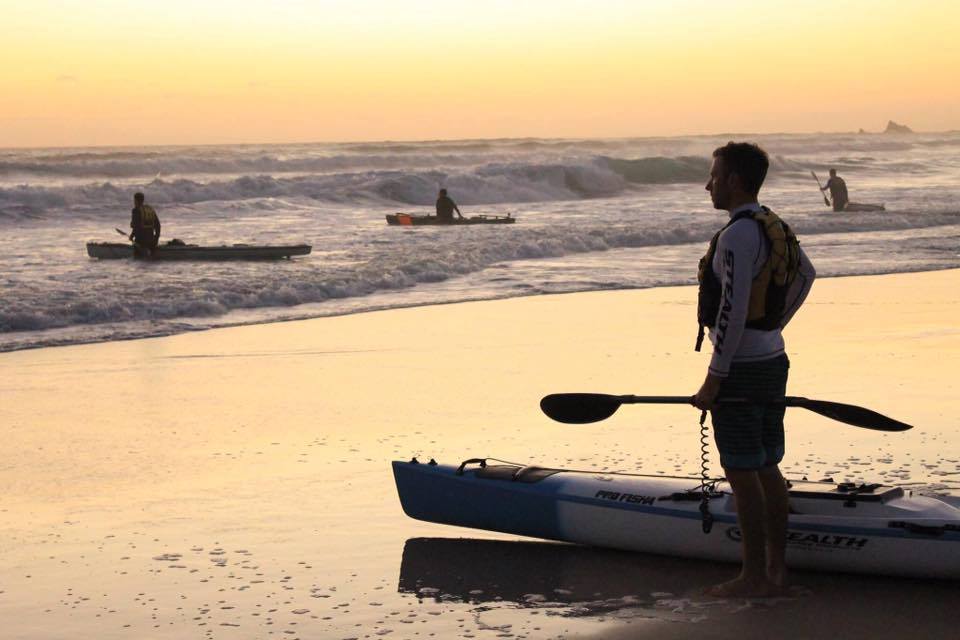
Surf Launch 101 Part Two: Getting Out!

Matty surveying the launch at Palmy on a big day
As I mentioned in last week's article, I don't consider myself an expert in the surf zone by any stretch of the imagination, but here are a few tips for launching your kayak through the surf that have worked for me. Actually hopping onto your kayak and getting out is definitely one of the aspects of offshore kayak fishing that takes a bit of practice, but once you get it down pat it can be extremely rewarding. There's no better start to a day of fishing than battling through a big break and making it out unscathed!
In my experience there are 3 main different types of launches that you will encounter when kayak fishing depending on the size of the waves that day and the location...
Protected

Noosa Main Beach on comp day!
Protected beaches will usually sit tucked away in behind a headland or shoal in such a way that the breaking waves have either lost power by the time they reach it or simply won’t form an extensive surf zone, such as at Noosa’s main beach or many of the headland beaches around Coffs Harbour. I would characterise these as beaches that usually only have one break.
On some beaches such as Moffats, even though they're protected, the sand can form a particularly steep shelf and the result of this is a pretty vicious vertical shore dump when the swell is up. Waves like this aren't fun when they crash on your face, but the upside is that one wave is all you have to deal with and if timed properly can just be walked past and avoided completely.
Protected breaks are definitely the best places to start out and won't present too much danger to the inexperienced paddler, but it's always still worth making sure that you're prepared- be sure to have a look at last week's write up for a few tips.
Semi-protected

An Adder Rock launch in nice conditions- nothing serious, but when the swell gets up there's definitely a few waves to deal with!
These beaches will usually lie on the northern side of a headland on the East Coast which provides some protection from swell, but they still have a bit of wash about them and when conditions are big can present a decent challenge. Think places like Cylinder Beach at Straddie, Fingal or Kingscliff and you’ve got your measure! Generally though, so long as there isn’t big swell hitting them directly they shouldn’t present much of an issue.
These are the best types of beaches to start gaining a bit of experience at launching with a bit of swell. If you're looking at tackling an open beach launch in anything less than ideal conditions, make sure you spend a good few trips playing around in the waves, falling off and gradually expanding your comfort zone in a semi-protected area beforehand. That said, don't underestimate any surf zone or what they can be capable of and always stay safe.
Open Beaches
Some fairly solid waves! (pic by Steve Evans)
Large, long, open surf beaches that are exposed to the east coast tend to have the toughest launches and crank especially hard in east or southeast swells. The majority of the time, these beaches will have 3 distinct breaks to negotiate- a shore break, a mid break and an outer bank. Outer banks are the real ones to watch out for as there is some serious power out there, but if you pick your days and times it’s possible to launch from open beaches without waves even breaking over that bank.
These banks are usually deeper than the close in ones and will usually only break in larger conditions (1.3m+ swell) and are more likely to break on low tides, so if you’re not too confident in your launches then try and wait for lower swells and a good high tide and most places will be fairly tame! Perhaps the greatest danger with some of these areas though is the sheer length of the surf zone- in some areas the last waves will lie some 200m+ out from the beach which makes for a tiring paddle out or if you’re unlucky, a long swim back in!
Step-by-step
Here's a step-by-step breakdown about how I personally go about tackling an open beach launch. As I've mentioned a few times before, it's not necessarily the 'right' way and I'm sure much better paddlers than myself will disagree with certain things, but hopefully if you're just starting out in the surf zone this should be a decent resource. In my experience, the most important things to get right are patience and timing. If you can wait for a perfect gap and time it right then you'll be able to conquer most beaches in reasonable conditions, but it's not always easy to wait around for the perfect moment when you're bobbing around in the waves!
To punch through the shorey, just wade out a fair way (make sure you're in deep enough water for the kayak to float once you're on board), wait for a bit of a lull in the waves directly in front of you then hop on and paddle quickly and hard. In this first break especially, don’t stop paddling once you commit or you will be making things very hard for yourself. Also, this should be obvious, but always keep the nose of your kayak pointed directly into any waves that you are punching through or you'll be tipped over very quickly! Often you will cop a wave here in the chest, but the good part about the shore break is that on most beaches it won't have the same power as the banks further out so if you hit it hard and fast, you can usually manage to punch through upright even if you don't perfectly pick the gap.

Go hard or go home!!!
The 1st Gutter/Mid Break
This should now see you in a calmer water with waves breaking in front of you and the shorey dumping behind you. Feel free to take a breath and relax a bit here. If you judge your positioning well you will be able to sit where you are for as long as you like without any problems. If you look towards that next break you should notice that it will break fairly consistently in one spot with whitewater travelling towards you, then petering out into foam before calming down and entering the gutter that you’re sitting in as smooth swell. I find that the ideal place to sit and wait for the gap is juuuust in that foam- after it has lost its power but as close to the break as possible without getting knocked backwards/off. This shortens the distance that you have to paddle to close the gap before the next wave when you do decide it’s time to go.
Usually it will be fairly obvious when a lull comes up after some foam has rolled underneath you- just be patient and wait for it! Again, once you do decide to go, paddle hard and fast and don’t stop until you’re past that break and into the next gutter. If you do get knocked off though, try and keep a hold of your kayak/paddle leash and let yourself be swept back into the gutter so that you have some calm water to remount in before having another crack.

Probably aim to not do this!
(pic from Chris Cooper)
The 2nd Gutter/Backline
Now (if you haven’t picked your day terribly well) for the fun part- the backline! Much like tackling the mid break, the final push is often just a matter of waiting in safe water until you can pick a nice gap and shoot straight out and get stuck into the fishing. The main difference with the back line however is that due to the added power it’s longer, which means that you have to paddle further to get past it. As a result, I personally find timing it a bit trickier (others may disagree), but the good news is that an outer line will rarely be unbroken. By this I mean that it’s less of a consistent wall of water and there will be a few gaps of clean, unbroken swell, meaning that it’s often possible to duck around a back break instead of pushing straight through it. If it's just a wall of water though, you've probably picked a pretty average day to go fishing!!!
You can quite happily cruise up and down the gutter parallel to the beach in order to find a gap like this if you haven't been able to pick a clean launch spot from the beach. Sit and watch and if you see that an area just has swell rolling through which isn't standing up and breaking, aim straight for it and go- very very quickly! It’s particularly important to judge this well as turning your kayak to aim for gaps can leave you vulnerable to getting hit by a wave on a sideways angle should a wave curl over and break on you which rarely ends well. It definitely pays to have practiced here so that your judgement is up to speed! Getting knocked off out on the backline sucks too- the waves are extremely powerful and if one breaks right on top of you near the end of the set you’ll often get pushed back a loooooong way into the deepest gutter on the beach. I can say from personal experience that this is not particularly fun early in the morning, so, again, if you’re not prepared to deal with getting thrown around then please consider waiting for conditions to improve.

Picking the gap out the back is always a good feeling!
(Pic from Chris Cooper)
Hopefully you’ve now made it past the danger zone now, so keep on paddling out a bit further (always give yourself plenty of room), rig up and get stuck into some fish!
Practice Makes Perfect
As you may have noticed, a lot of the skills required when launching (and returning for that matter- but more on that later!) revolve around being able to judge whether or not you can make a gap in a set. It can be a bit tricky at first, but the best way to get to a point where you can get make correct calls on a fairly consistent basis is to go out and play in the waves as much as you can. If the fish haven't been chewing, put your gear back in the car after a session and go for a paddle- learn how to pick the gaps and time waves. Even if the swell isn't huge on any given day, you can gain valuable experience in timing by aiming to hit clean water and avoid having any waves break on you. It's also good fun on the right day so there's no excuse for not setting aside a bit of time for a surf session if you're still fearing the launch!
Hopefully this helps a few of you get out and enjoy a few different spots along the coast- just always remember to be sensible about what you take on when it comes to surf and don't step too far outside of your comfort zone until you've got a bit of the experience needed to handle it!
Next week- how to get back in (hopefully) upright and in one piece!
Cheers,
Owen Gray

